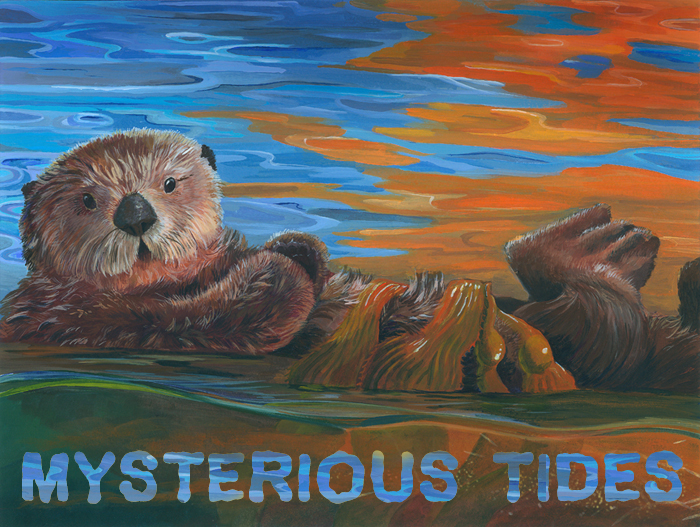
|
| Illustration: Katie Bertsche |
| Toxic blooms of marine algae are getting worse, and some think we’re to blame. Marissa Fessenden sleuths out the story. Illustrated by Katie Bertsche and Lucy Conklin. |
 |
Beneath the ocean-weathered planks of the Santa Cruz municipal wharf, a sleek sea lion snorts and rolls languidly in the waves. Honey-gold sunlight glows through gauzy morning mist. Ian Hunter, an undergraduate from UC Santa Cruz, eyes the surging swell. The waves are high and heavy, colored dark green with tints of yellow and brown—like a fading bruise. Graduate student Lisa Ziccarelli joins Hunter on a dock below the pier. The boards are slick, but this morning’s mission demands that someone cross the slippery timbers.
Ziccarelli dashes down a small flight of stairs to the edge of a platform, uncomfortably close to the waves. She reaches over and hauls up a rope festooned with brightly colored disks. Each disk has a teabag-like pouch, holding plastic beads the size of millet grains. They’ve floated in the surf for a week, gathering chemicals that drift unseen in the water. The students will take those bags back to a lab on campus to analyze them for traces of poison.
The poison comes from marine algae, also called phytoplankton. Normally, algae float harmlessly through the waves, soaking up sunlight. When the water chemistry and temperature are right, they bloom in rapid spurts of growth, sometimes even coloring the waves. Most algae are benign, but some blooms spout toxins. Endangered sea otters, dolphins, sea lions, and humans have all gotten sick or died from eating the marine creatures that devour algal blooms.
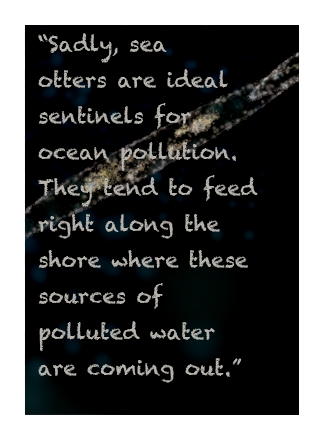 In the past three decades, blooms have hit harder and longer than ever before. Experts debate whether the increase is part of a natural cycle or something triggered by human action. Clouding the discussion, climate change may play a role. It used to be that harmful blooms appeared only in the spring and fall, says UC Santa Cruz marine scientist Raphael Kudela. Now, his students find traces of different algal toxins all year round. Untangling why can help scientists warn coastal residents when the tide might turn toxic. In the past three decades, blooms have hit harder and longer than ever before. Experts debate whether the increase is part of a natural cycle or something triggered by human action. Clouding the discussion, climate change may play a role. It used to be that harmful blooms appeared only in the spring and fall, says UC Santa Cruz marine scientist Raphael Kudela. Now, his students find traces of different algal toxins all year round. Untangling why can help scientists warn coastal residents when the tide might turn toxic.
New tools may help that quest: a network of gliding robots, satellite-driven computer models, and sophisticated underwater sensors to track blooms from Monterey Bay to Southern California. The massive undertaking—funded by a five-year, $4.3 million grant from the National Oceanic and Atmospheric Administration (NOAA)—is the most sensitive algae-monitoring array ever deployed on the west coast.
“The big question is: Are the blooms really spreading or are we paying more attention?” says Kudela. “This is about applying new technology to either mitigate or fix the problem.”
A study in scarlet
Blooms of harmful algae are not new. For centuries, elders from the Quileute Nation of Washington’s Olympic Peninsula have passed down knowledge of when it is safe to harvest shellfish. They know to avoid mussels, clams, abalone, and oysters during certain seasons.
Potent poisons from a handful of phytoplankton species work their way insidiously into the food chain, accumulating in mollusk tissues and eventually killing fish and larger mammals. Harmful blooms also exact an economic toll. Toxins in mollusks make shellfish flesh poisonous, and fishermen lose entire crops. According to a 2008 report from NOAA, harmful blooms cost the U.S. more than $82 million each year.
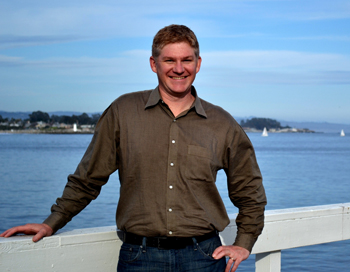 />
Photo: Marissa Fessenden |
UC Santa Cruz marine science Raphael Kudela on the Santa Cruz Municipal Wharf. (Click on image to see larger version.) |
|
|
Toxic algal blooms are dubbed “red tides,” named after the red hue of photosynthetic pigments in some algae. However, these tides come in shades of green, brown, and gold as well. The most dangerous algae swirling in waters off California are Alexandrium catenella and species of Pseudo-nitzchia. The first produces saxitoxin, which causes paralytic shellfish poisoning by blocking sodium channels and silencing nerve activity. A severe case will stop your heart and halt your breath.
Domoic acid, from Pseudo-nitzchia, does the opposite. “It causes the nerves to fire chaotically, with no particular desire,” says David Caron, an ocean scientist at the University of Southern California. “So you have convulsions, delirium, loss of memory.” That last symptom gives domoic acid poisoning its name: amnesiac shellfish poisoning. In 2002, at least 400 sea lions died of domoic acid seizures in California.
More than half of unusual marine animal deaths—such as fish kills or whale and sea otter strandings—are linked to harmful algal blooms. It’s not clear why algae produce such potent toxins, says Caron. The poisons might give algae an advantage by slowing down competing species in a kind of chemical warfare. Or the toxins may make the phytoplankton taste nasty to krill and other critters that graze on them.
“The algae are not creating these substances to disrupt nervous function in higher organisms,” Caron adds. “I don't think Alexandrium and Pseudo-nitzchia care what sea lions and pelicans are doing. It's just an unfortunate side effect.”
The tiny algae are always in the waves, says Ken Bruland, a chemical oceanographer at UC Santa Cruz. When conditions are right, the few plankton living in the upper ocean start growing. One alga can divide twice each day. That rate means each single cell can become a thousand in four to five days. “You can stand on shore and actually see it,” Bruland says. “The water has a sort of brownish or reddish tinge. The organism just gets so abundant that it gives you color.”
A bloom attracts grazers like krill and copepods, which are dinner for herring and anchovies. If the bloom is toxic, it doesn’t harm the krill directly. “But you see it higher up on the food chain,” Bruland explains.
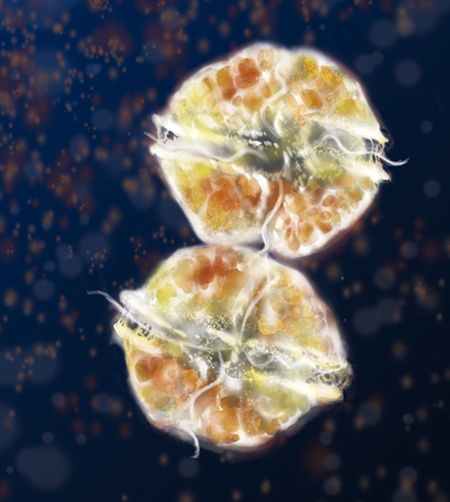
Illustration: Lucy Conklin
|
| Alexandrium catenella marine phytoplankton |
|
|
The best way to understand algal blooms is test the waves constantly. So Kudela’s lab gathers weekly samples. Lab manager Kendra Hayashi slits open each pouch of beads and extracts chemicals they have soaked up. While Hayashi extracts, Hunter examines water samples under a microscope. Today he sees a lot of sand and dirt, washed into the sea by last night’s rains. Zooplankton zoom in and out of view. They are fuzzy and out of focus, but Hunter ignores them as he searches for algae. A few of them, dinoflagellates, whirl and rotate slowly. One looks like a tiny golden spaceship. Others, the diatoms, look like shards of glass, one a beautiful aqua color. Hunter marks down all the species he finds, searching for javelin-shaped Pseudo-nitzchia or fractured volleyball-shaped Alexandrium.
When the lab finds toxins, Kudela sends an alert to the California Department of Public Health. If the level is high, the department shuts down shellfish harvesting and posts notices in newspapers and on beaches. When samples test clean, they lift the ban. Today’s sample doesn’t have any dangerous species, so fisheries are safe this week. But later in the season, toxins could flood the water—as they have all too often in recent years.
Lethal tides
When dead sea otters washed up on the shores of Monterey Bay in 2007, veterinarian Melissa Miller of the California Department of Fish and Game got suspicious. Their gums and the whites of their eyes were bright yellow, a sign of liver damage. “It looked totally unlike anything I could remember,” Miller says. When she cut into the bodies, she found swollen and deteriorating livers. “They were so fragile that when I picked them up, they would fall apart in my hands.”
 Illustration: Lucy Conklin
Illustration: Lucy Conklin |
Pseudo-nitzchia marine phytoplankton |
|
|
Miller drew up a list of what could cause such damage. Lightning strikes can trigger liver failure, but as the death toll mounted to seven otters, that cause seemed unlikely. Poisoning by death cap mushrooms was out, unless the otters ventured ashore in search of an exotic fungal diet. She narrowed her list to microcystin, a toxin known to cause liver damage in cows and humans. But that toxin— as potent as arsenic—comes from blue green algae, which grow only in fresh water. Miller consulted Kudela to figure out how a non-marine algae could end up poisoning ocean-dwelling sea otters.
A search for freshwater sources that drain into Monterey Bay led the pair to Pinto Lake in Watsonville, 17 miles south of Santa Cruz. Water samples from the lake were rife with microcystin; globs of algae floated on the surface like fluorescent green paint. Next, Miller and Kudela exposed the otters’ favorite shellfish to the toxin. The digestive tracts of the crabs and mollusks held enough poison to kill, they found. Ultimately, the body count that year hit 21.
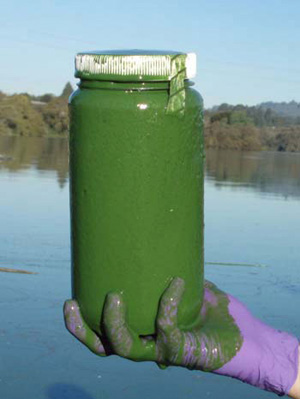 Photo: R. Ketley
Photo: R. Ketley |
The toxic cyanobacteria Microcystis gives this water sample from Pinto Lake its bright green color. |
|
|
“Sadly, sea otters are ideal sentinels for ocean pollution,” Miller says. “They tend to feed right along the shore where these sources of polluted water are coming out.” The most disturbing part of the story, she says, is that regulators don’t test seafood for microcystin. No one suspected a toxin from freshwater algae could end up in the ocean.
When algae are suspects in marine animal deaths, Kudela is one of the experts called to solve the case. For instance, sea stars, abalones, and chitins washed up in Sonoma County in December 2011, turning rocky beaches into shell-ridden graveyards. The shellfish kill coincided with a bloom of algae that produces yessotoxin. But that particular poison normally isn’t strong enough to kill abalone, leaving scientists like Kudela puzzled and frustrated. “We think we're pretty good at figuring [the kills] out,” he says, shaking his head. “But this one . . . nobody has a really good idea of what happened.”
This doesn’t bode well for next season. Blooms can deposit a layer of phytoplankton spores on the ocean bed. Just as dandelions in a lawn will pop up again and again, algal blooms reoccur. Kudela is concerned a similar bloom will resurface, but researchers aren’t ready.
Mixing the poison
Teasing out specifics of why these blooms occur is tricky; Monterey Bay is a unique setting. “The reason we have so much sea life and bird life in this area is because the ocean is so productive,” explains Kudela. “That productivity is the algae growing in the ocean. It’s like grasses on the land—that’s what everybody is eating.”
|
Marissa Fessenden explores the beauty—and dangers—of marine algae with one of the field's pioneers, UCSC's Mary Silver. |
|
|
 Wind and geography drive the bay’s richness. The land bounds water on the east and strong winds blow from the northwest. That movement of air over sea pushes water near the coast southward, leaving room for cold water to well up from the depths off the continental shelf. The deep Monterey Canyon extends like a finger into the center of the bay, bringing the deep ocean unusually close to shore. These features keep the waters chilly and rich in nutrients that feed phytoplankton blooms, which fill the bellies of anchovies and sardines, which are gobbled up by larger fish, which in turn make tasty meals for seals and whales. Wind and geography drive the bay’s richness. The land bounds water on the east and strong winds blow from the northwest. That movement of air over sea pushes water near the coast southward, leaving room for cold water to well up from the depths off the continental shelf. The deep Monterey Canyon extends like a finger into the center of the bay, bringing the deep ocean unusually close to shore. These features keep the waters chilly and rich in nutrients that feed phytoplankton blooms, which fill the bellies of anchovies and sardines, which are gobbled up by larger fish, which in turn make tasty meals for seals and whales.
“That also means that the toxin can get into all those different animals quickly,” says Kudela.
The bay has a pocket in its northeastern corner, just south of Santa Cruz. There, mountains shelter the water from the winds, and the curving coastline deflects the coldest filaments of the upwelling. Instead, nutrient-rich waters swirl around in a counter-clockwise swoop, gradually warmed by the sun. The result is a stew of warm nutritious broth, occasionally refreshed by runoff from the Pajaro River. It’s a perfect nursery for algae.
“Here is where these blooms can get started and where they can get exported to other regions of the coast," explains John Ryan, a research specialist at the Monterey Bay Aquarium Research Institute (MBARI) in Moss Landing.
Watson the robot
One man alone can’t untangle these complex interactions of wind and water. Every Sherlock needs a Watson. For oceanographers and algae researchers, their data-gathering sidekicks are robots.
 Measuring algal blooms using satellites and samples from boats is very useful, but to really think like an alga, Ryan explains, you need to move like one. “We wanted to use autonomous underwater vehicles (AUVs) to pretend they are plankton,” Ryan says. Measuring algal blooms using satellites and samples from boats is very useful, but to really think like an alga, Ryan explains, you need to move like one. “We wanted to use autonomous underwater vehicles (AUVs) to pretend they are plankton,” Ryan says.
The school-bus-yellow, torpedo-shaped robots deployed by MBARI are “dorado-class” AUVs, named for the fast-moving fish. The 8-foot-long bots swoop through the water as fast as a person walking briskly. Each dorado uses its sophisticated electronic “nose” to sense chemicals. When it sniffs out hints of an algal bloom, the AUV grabs a water sample—gulping in almost two liters in less than two seconds. “That gets us a snapshot of the plume,” Ryan says. The AUVs help him map the phytoplankton blooms as ocean currents push them, as wind pulls them apart, and as they grow or are eaten by other plankton.
|
Illustration: Lucy Conklin |
|
|
As each AUV cruises the bay, a second class of robot squats on the sea floor. Looking like a Star Wars droid, the Environmental Sample Processer (ESP) is a sophisticated “lab-in-a-can.” Unlike the dorado, it sips water daintily. Inside its body, on an internal platform complete with little robotic arms, the ESP sorts plankton and cracks them open to analyze their DNA. When it finds algae of interest, it pings researchers with a text message.
With robotic help, Ryan and Kudela matched toxic blooms with the first rainfall of autumn, called the “first flush.” Rain coursing through agricultural fields and city streets wash a summer’s worth of fertilizers and waste out to sea. That runoff is full of urea, a compound in mammal urine, which comes from leaky septic tanks and farms. Urea is rich in nitrogen, a necessary nutrient. Algae eagerly gobble it up, but it doesn’t seem to sit well with them. “In many cases if you give Pseudo-nitzchia urea, it makes them much more toxic,” Kudela says.
The strawberry fields of Salinas Valley drain directly into Monterey Bay. “Even over the last 10 years, nutrient conditions in places like the Salinas River are going up very, very rapidly,” Kudela says.
The new grant will let the research team deploy more robots, including small winged gliders that run on batteries for months at a time. All the high-tech aides will help the researchers pinpoint conditions that lead to the most toxic blooms—and issue timely, detailed warnings to coastal residents. Kudela says that the early warning can help fishermen plan their hauls. Wildlife centers will know when to expect trouble, too.
One of the major goals is to compare conditions in Monterey Bay and Southern California. Caron, the algae expert in Southern California, is in charge of monitoring the waters around Los Angeles. Monterey Bay gets agricultural runoff, but Southern California has grit and waste from city streets. The two locations may reveal what prompts the algae to bloom and what favors the most hazardous species.
Catching the culprit
While algae deliver the poison, humans might be the cause.
“Those nutrients which we apply to our land, our crops, our lawns, and our flowers, some of them run off into our coastal waters,” says Pat Glibert, a marine ecologist at the University of Maryland. “They have the same effect at the microscopic level: They promote the growth of plants.”
A warming planet and changing rainfall patterns brew the perfect conditions for algae. Whether climate change is a major driver of this shift is still a puzzle, Glibert says. She points out that in India the timing of monsoons has changed, affecting the flow of water and nutrients to the ocean. “These kinds of blooms are occurring on all coasts and continents,” she says.
Don Anderson, a marine biologist at the Woods Hole Oceanographic Institution in Massachusetts, agrees that scientists have found more species of algae, more types of toxins, and more areas affected by harmful blooms around the world. “But to try to generalize any sorts of trends over that huge diversity of habitats and species and so on is doomed to failure,” Anderson says. For example, the coastline of Massachusetts to Maine sees yearly toxic blooms. The trend stretches back only to 1972, when an enormous red tide occurred; prior to that, the record is clean.
 Humans did not cause this particular trend, Anderson says. An unusual weather pattern in 1972 carried the bloom south from Canadian waters. That single event dropped spores up and down the coast. Now, the yearly outbreak draws on that seed bank. “The problem is much bigger than we used to think it was,” Anderson explains. “Part of that new awareness is because we have better data and instrumentation. And part of it is because it is getting bigger.” Humans did not cause this particular trend, Anderson says. An unusual weather pattern in 1972 carried the bloom south from Canadian waters. That single event dropped spores up and down the coast. Now, the yearly outbreak draws on that seed bank. “The problem is much bigger than we used to think it was,” Anderson explains. “Part of that new awareness is because we have better data and instrumentation. And part of it is because it is getting bigger.”
California’s complex ecosystem makes it difficult to trace blooms to humans. We are not the only cause for the increase in harmful algal blooms, Kudela agrees. “But we can point pretty conclusively to things that humans are causing, and there is almost no way they are not making things worse.”
How much worse? If scientists want to persuade policymakers to tighten regulations on runoff, they need to know. In the meantime, Kudela’s team will keep sampling the waves for whiffs of poison. With each clue they gather, we’ll come closer to understanding these toxic tides.
Story ©2012 by Marissa Fessenden. For reproduction requests, contact the Science Communication Program office.
Top
Biographies
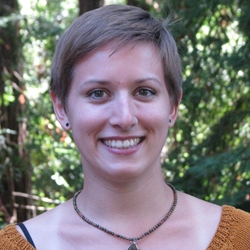 Marissa Fessenden Marissa Fessenden
B.S (interdisciplinary studies, biology and writing) Cornell University
Internship: Scientific American (New York)
I illustrated my chemistry notes with molecules morphing into faces and poems about reactions. The doodles were signs: I was worried that a biology career would not let my creative half breathe. Then a friend asked, "What are you proud of?” I remembered my essay on the Hubble Space Telescope that won a statewide contest. I decided to be a writer, but astronomy seemed too distant a subject.
On a trip to India, I saw healthy, happy faces in a village transformed from poor to prosperous by water-management techniques. Later, in a neuroscience lab, I learned that some people think vaccines cause autism. These stories drew me in. I wanted to know what people thought of science: how it changed them, or why it threatened them. Now, I illustrate life with words as a science writer.
. . . . . . . . . . . . . . . . . . . . . . . . . . . . . . . . . . . . . . . . . . . . . . . . . . .
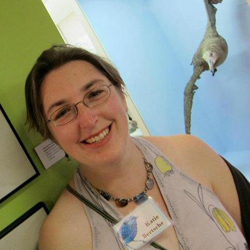 Katie Bertsche Katie Bertsche
B.S. honours (zoology) University of New South Wales, Sydney, Australia
Natural Science Illustration Certificate, Rhode Island School of Design
Internships: Smithsonian Institution Division of Birds, UC Berkeley Vertebrate Zoology Museum
My first real scientific illustration was a graphite drawing of several tiny extinct marsupial teeth that I made while at University in Australia. I took a long hiatus since then but I am so happy that I am now formally working in illustration with a greatly expanded repertoire of techniques and interests. I love painting birds and extinct Pleistocene megafauna, and using art to inspire young people to get involved with science. Natural history museums are my native habitat. When not drawing and painting for field guides and exhibits, I am usually out birding, roaming the world in search of adventure or professional cycling races, or making electronic textiles.
. . . . . . . . . . . . . . . . . . . . . . . . . . . . . . . . . . . . . . . . . . . . . . . . . . .
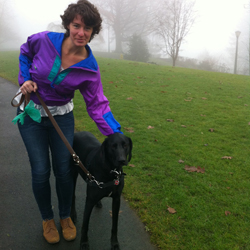 Lucy Conklin Lucy Conklin
B.A. (physics) Bucknell University
Internships: Denver Museum of Nature and Science, `
Exploratorium (San Francisco)
As a child of two biologists, I assumed all adults knew the scientific names of wildflowers. I knew terms like “rigor mortis” and I assumed backyard dissections were normal. This early introduction to the sciences eventually led me to pursue physics in college. After a brief diversion to New York City, I returned to the sciences by way of the arts. It is my hope that my illustrations encourage young people, and especially young women, to get excited about the sciences. Please visit my website for more examples of my work.
Top |

